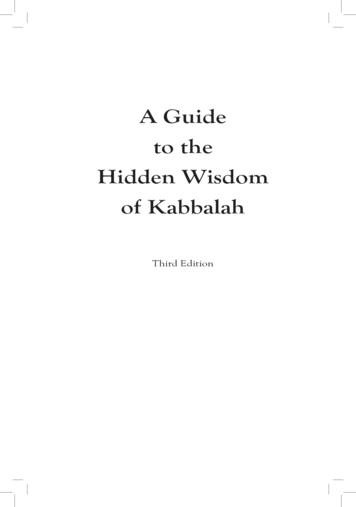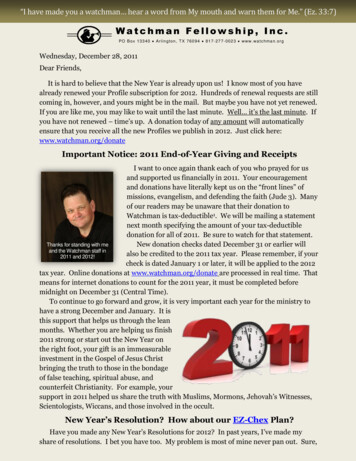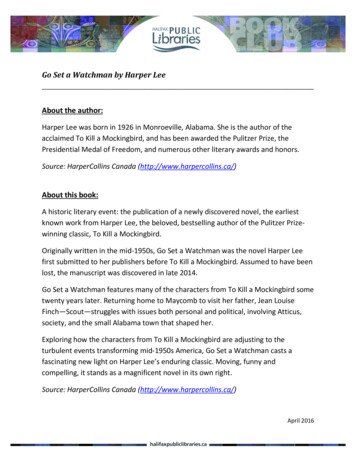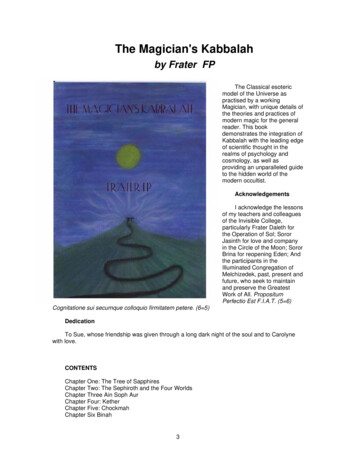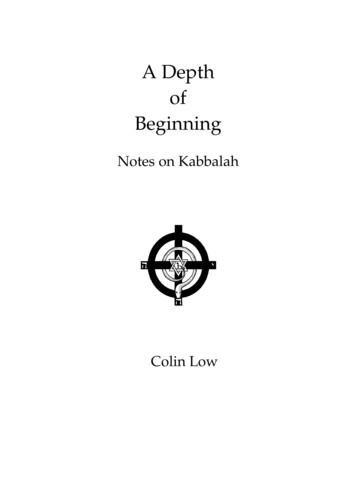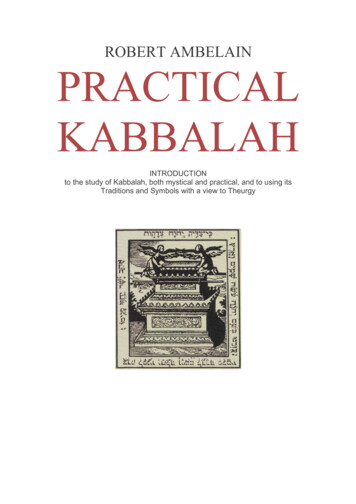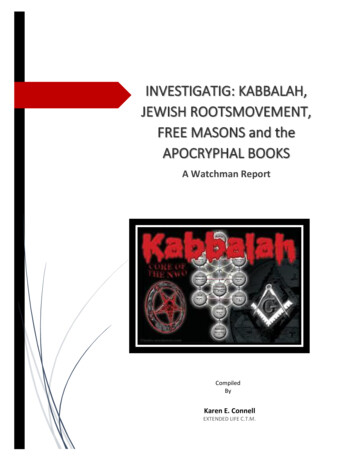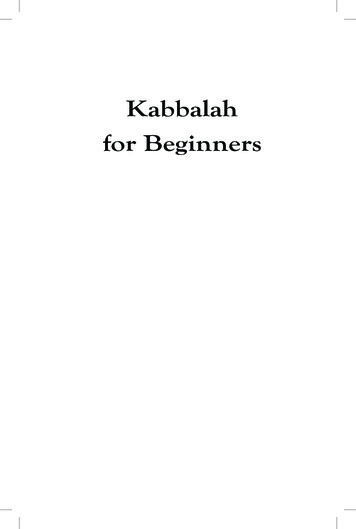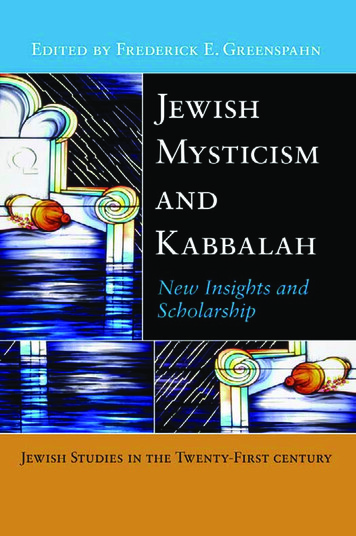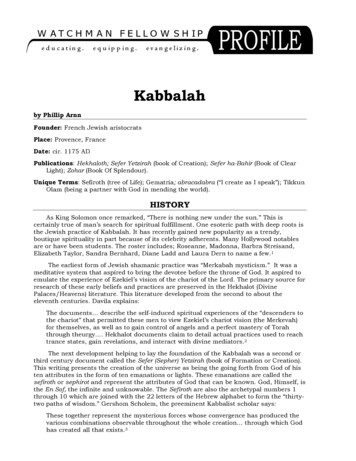
Transcription
Kabbalahby Phillip ArnnFounder: French Jewish aristocratsPlace: Provence, FranceDate: cir. 1175 ADPublications: Hekhaloth; Sefer Yetzirah (book of Creation); Sefer ha-Bahir (Book of ClearLight); Zohar (Book Of Splendour).Unique Terms: Sefiroth (tree of Life); Gematria; abracadabra (“I create as I speak”); TikkunOlam (being a partner with God in mending the world).HISTORYAs King Solomon once remarked, “There is nothing new under the sun.” This iscertainly true of man’s search for spiritual fulfillment. One esoteric path with deep roots isthe Jewish practice of Kabbalah. It has recently gained new popularity as a trendy,boutique spirituality in part because of its celebrity adherents. Many Hollywood notablesare or have been students. The roster includes; Roseanne, Madonna, Barbra Streisand,Elizabeth Taylor, Sandra Bernhard, Diane Ladd and Laura Dern to name a few.1The earliest form of Jewish shamanic practice was “Merkabah mysticism.” It was ameditative system that aspired to bring the devotee before the throne of God. It aspired toemulate the experience of Ezekiel’s vision of the chariot of the Lord. The primary source forresearch of these early beliefs and practices are preserved in the Hekhalot (DivinePalaces/Heavens) literature. This literature developed from the second to about theeleventh centuries. Davila explains:The documents describe the self-induced spiritual experiences of the “descenders tothe chariot” that permitted these men to view Ezekiel’s chariot vision (the Merkevah)for themselves, as well as to gain control of angels and a perfect mastery of Torahthrough theurgy . Hekhalot documents claim to detail actual practices used to reachtrance states, gain revelations, and interact with divine mediators.2The next development helping to lay the foundation of the Kabbalah was a second orthird century document called the Sefer (Sepher) Yetzirah (book of Formation or Creation).This writing presents the creation of the universe as being the going forth from God of histen attributes in the form of ten emanations or lights. These emanations are called thesefiroth or sephirot and represent the attributes of God that can be known. God, Himself, isthe En Sof, the infinite and unknowable. The Sefiroth are also the archetypal numbers 1through 10 which are joined with the 22 letters of the Hebrew alphabet to form the “thirtytwo paths of wisdom.” Gershom Scholem, the preeminent Kabbalist scholar says:These together represent the mysterious forces whose convergence has produced thevarious combinations observable throughout the whole creation through which Godhas created all that exists.3
THE BEST RESOURCE COLLECTION ON CULTS AND RELIGIONSThe Watchman Fellowship ProfileNotebook provides you with an extensive personal library of information about cults, new and alternative religions, world religions, andreligious leaders. You will have atyour fingertips over twenty years ofresearch to answer your questions,strengthen your faith, and improveyour witness to others. Over 100 ProfilesOver 400 pages of informationThe history and primary teachings ofeach groupA Christian responseto deepen your faithand enhance your outreachClick here to order your copy of the watchman fellowship profile notebookBe sure to also order your free subscription to the Watchman Fellowship Profile. Several timeseach year you will receive a new, four-page Profile that you can add to your Profile Notebook, aswell as the latest news from Watchman Fellowship. Click here to order your free subscription!
Kabbalah, page 2This early literature owes much of its content to the ideas of the Greek mathematicianand philosopher Pythagoras and his school at Croton, Italy. J. A. West writes, “ a muchquoted Pythagorean principle was ‘Number is All.’ Creation was described as the divisionof the primordial unit into multiplicity and diversity.”4Other Pythagorean concepts of the soul of man and the problem of sin were adopted: a fallen, polluted divinity incarcerated within the body, as in a tomb from which itcan gain release through ritual purgation, accompanied by ascetic abstinence.Pythagoras . adopted the idea of Orphism of a process of bilocation, according towhich the soul could be detached from the body.5Add to this the belief in reincarnation that Pythagoras brought from his time in Persia.The Jewish mystics also at this time added to the belief in the divine nature of numbers,the idea of the archetypal nature of the letters (also practiced by the Pythagoreans) of theHebrew alphabet. The 22 letters of the Hebrew alphabet were assigned numeric values.This is called gematria. The Babylonians used this practice by the 8th century B.C.E and itwas later practiced by the Greeks. It was based on a 27-letter alphabet that correspondedto three numeric enneads (1-9, 10-90 and 100-900). By the 2nd century C.E. the Jews haddeveloped 22 letters and five dual use letters. The names of God were computed. Words inthe Torah with equal values were placed together to find the deeper meaning of God’sWord.6The Merkavah mysticism, incorporating the ideas and practices of the Hekhalot andthe Sefer Yetzirah, was always a small peripheral stream within mainline Judaismresidents in groups like the Essenes, best exemplified by the Qumran community. Itcontinued as the main expression of Jewish mysticism until the next major building blockcame forth in the twelfth century, the Sefer ha-Bahir.The Sefer ha-Bahir (Book of Brilliance or Illumination) is considered the first trulyKabbalistic work. It was written or compiled in Provence, France in 1176. Its form was as aset of dialogues among fictional rabbis and students written as questions and answered byparables. It revised the sephirot as being dualistic oppositions; light and darkness, mercyand justice, male and female, etc., that were temporal copies of divine realities. Thesedualities representing divine archetypes replaced the Hellenist concept of numbers as theprimordial emanations. It was a Midrash or commentary on the opening verses of thecreation story in Genesis as well as other scriptures. It also taught reincarnation.7 It wasextensively used in the next significant text of mystic importance, the Zohar.In the 13th century, Moses de Leon, a Jew in Spain, revealed the Zohar. The Zoharreveals that the Unknowable God, Ein Sof, can be known only through the emanationscalled sefiroth. The first of the sefirah is known as Kether and is Nothingness. Nothingnesstakes on potential as the second sefirah, Hokhmah, or Wisdom. The Pythagorean conceptof the number one represented by a single point is de Leon’s Hokhmah. The next sefirahis Binah, Intelligence. Scholem interprets, “In the following Sefirah the point develops intoa ‘palace’ or ‘building’ – an allusion to the idea that from this Sefirah, if it is externalized,the ‘building’ of the cosmos proceeds. In it all forms are already preformed, but stillpreserved in the unity of the divine intellect which contemplates them in itself.”8Binah gives birth to all of creation as a mother gives birth to her children. Scholemgoes on to explain that the remaining seven sefiroth are equated with the seven days ofcreation that spring forth from the womb of Binah. All of the sefirah unite in the ninthsefirah, Yesod from whence they flow into the last that is Malkuth or Shekhinah. TheZohar taught that the literal community of Israel was in correspondence to the mysticalKingdom that is Shekhinah.9 Thus, there are two planes of emanation; the upper plane ofthe sefiroth and the lower one of temporal creation.In 1492 all Jews were forced to leave Spain. They migrated eastward into Europe,southward to northern Africa and many returned to Israel. A small village north of the Sea
Kabbalah, page 3of Galilee called Safed became the new center of mystical thought. Its leading light was aman named Isaac Luria. His contributions to Kabbalism were historic and lasting. First,he elaborated on the creation myth of the Zohar. Ein Sof was the All in All. In order for acreation to come forth there would have to be a place for it. Ein Sof would have to goinward or contract within Himself. Luria called this Tsimtsum. The first act of creation wasthe act of Tsimtsum. But, the nothingness created retained a residue of the Divine Lightcalled Reshimu. This idea was found as early as the second century in the doctrines of theGnostic, Basilides.10The first emanation or self-revelation from Ein Sof was a ray of light that brought forththe form of a man called Adam Kadmon. From all of the orifices of the head of AdamKadmon came forth rays of light. Out of Ein Sof came a second emanation of vessels intowhich the lights would differentiate into the first three sefiroth. The remaining sevensefiroth came forth as one explosive beam and shattered the vessels that were to containthem. The seeming tragedy is called the “breaking of the vessels.” But, Luria saw this asthe birth process to separate out the dross. The light contained a latent property calledKelipot, or evil. The shards of the vessels, with the remaining spark of divine light and theKelipot, were mixed and fell into the lower regions. The Kelipot became the demonic forcesthat disfigure the creation.11For Luria, the purpose of existence is to restore the creation to its original purityabsent the Kelipot. This salvation process is called Tikkun. The final manifestation of EinSof and His Kingdom as the perfect Adam Kadmon throughout all of the createddimensions is dependant upon his creation undertaking the ministry of Tikkun. To Luria,the Jews, with the light of the Torah and the power of their prayers, and the purity of theirlives were as important to God’s plan as the original act of Tsimtsum. Israel was to engagein the Messianic ministry of restoration. The coming of the Messiah would see therestoration of Israel and the culmination of Tikkun.12Kabbalah mysticism also had its effect upon the Christian community. In 1486Giovanni Pico della Mirandola (1463-1494) in Italy produced a set of propositions to showhow the Cabala (note the different spelling commonly used for the “Christian” Cabala)supported the doctrine of the Trinity and the incarnation of Christ. His rough ideas wereexpanded by his protégé, John Reuchlin (1455-1522) and finally Paul Ricci (1470-1541) aconverted Jew.13 Together, their work presented the first three sefiroth as The Father(Kether), The Son (Chokmah), and the Holy Spirit (Binah). Out of Kether came the light(Jesus/Chokmah), “He was the light of the world.” In the material world He is Tiferet, thecenter of all creation. He is the King of Malkhut, the Kingdom of the redeemed. Reuchlininterpreted Jesus as saying, “I am Tiferet, Hokhma, and Malkhut. No one comes to Ketherexcept through me” (John 14:8ff).14By the mid 1800s a major departure from Judaic Kabbalah was taking place. InFrance, the occult author of The Dogma and Ritual of High Magic, Eliphas Levi, had mergedthe Sephiroth from the Qabalah (note the spelling which is indicative of occultinterpretations) with the Tarot to produce a new foundation for occult study andpractice.15 Levi’s work was taken up by Dr. William Wescott, Dr. William Woodman and S.MacGregor Mathers, the founders of the Esoteric (later, Hermetic) Order of the GoldenDawn in England in 1888. Jan Swanson describes the Order as being “a magikalorganisation which incorporated Judaic Kabbalah, Egyptology, Resicrucianism, ritualmagic, astrology, tarot, and the Indian tattwa system (as interpreted through Theosophy).According to the teachings the cosmos is divided into ten fundamental archetypalessences; the ten sefirot . The Sefirot as understood in the Golden Dawn system are notso much attributes of God as occult or psychic powers or archetypes, which weresecondarily located within the human body.”16The renaissance of public interest in Kabbalah at the present has been generated byits celebrity adherents. Their teachers, the Berg family (father, Rabbi ‘Rav’ Philip Berg andsons Rabbis Michael and Yehuda) run the Kabbalah Centrex. What does the Kabbalah
Kabbalah, page 4Center offer? Michael Berg unveils the good news in his 2004 book, “Kabbalah teachesthat just as rocks are hewn from mountains, humans emerge from God. At the Level of thesoul, humans have exactly the same essence as God. In essence humans are like God.”17The Bergs have accentuated the New Age aspects of Kabbalah. They teach astrology, astralprojection, dream analysis, karma and reincarnation, energy balancing, and the power ofmeditating on Hebrew letters and words. They also promote the wearing of the red stringfor protection from the evil eye.18CHRISTIAN RESPONSEThe deepest yearning of every Kabbalist is union with God. Evangelicals may be ableto find some common ground as they also see humans, in their natural state, as beingseparate from God. But, unlike the evangelical solution to separation, Kabbalists oftenfocus on human effort and personal responsibility for the restoration of “the fallen sparks.”Scholem puts it this way:According to its recognized, orthodox interpretation, Israel has been dispersed amongthe nations in order that it may gather in from everywhere the sparks of souls anddivine light which are themselves dispersed and diffused throughout the world, andthrough pious acts and prayers “lift them up” . There are stages of the great processof Tikkum, the Messiah himself must descend into the realm of evil. Just as theShekhinah had to descend to Egypt-the symbol of everything dark and demonic – togather in the fallen sparks, so the Messiah too on his most difficult journey to theempire of darkness, in order to complete his mission.19To free the slave of sin from endless self-effort, the biblical Christianity offers thesimple gospel (I Corinthians 15:1-4). Many scriptures set forth who the Messiah is andwhat He has accomplished (John 1:1-5, 8-14.18; Ephesians 2:8-10). The atoning work ofthe Messiah on the cross, rather than “pious acts and prayers” bring union with God bygrace through faith alone (Titus 3:5). Jesus, the Messiah said “It is finished” (John 19:20).The Christian must make it known that the Messiah has already come. This is the GoodNews for the Kabbalist and for all people.Notes12345678Rabbi James Rudin, “Commentary: Kabbalah Comes to Hollywood,”Religious News Service (AP), 13 August 1999; David Van Biema, “Pop Goesthe Kabbalah,” Time Magazine, 24 November 1997, 92-94; Sue Facter,“Celebs embrace Jewish mysticism,” USA Today, 20 September 1996.James R. Davila, “The Hekhalot Literature and Shamanism,” Society ofBiblical Literature 1994 Seminar Papers, (Atlanta, GA: Scholars Press,1994) 767-89.Gershom Scholem, Major Trends in Jewish Mysticism (New York: SchokenBooks, Inc., 1995 ed.) 76.Richard Canendish, editor. Man, Myth & Magic An Illustrated Encyclopediaof the Supernatural,, (Italy: BPC Publishing Ltd., 1970) 2315-16.Michael Grant, The Classical Greek, (New York: Scribner’s, 1989) in excerpton internet at s.htm (accessed 2004).John Opsoqaus, “Some Notes on the History of Isopsephia (Gematria), onthe internet – www.cs.utk.edu/ mclennan/ BA/SNHIG.html (accessed2004).Attributed to Rabbi Nehunia ben haKana, “Sefer ha-Bahir – ‘The Book ofIllumination,’” www.darkwing.uoregon.edu/ sshoemak/102/texts/bahir.htm (accessed 2004).Gershom, Major Trends, 219.Ibid., 233.Ibid. 26411 Ibid. 26712 Ibid. 273-27413 William Varner, “The Christian Use of Jewish Numerology” TheMaster’s Seminary Journal,8/1 (Spring 1997) 47-59.14 Cindy Smith, “The Christian Cabala,” Essay, Jewish Mysticism,Professor Dr. David Blumenthal (Atlanta, Georgia: Emory University).On internet: www.digital-brilliance.com/kab/chriscab.txt (accessed2004).15 Eliphas Levi, Elements of the Qabalah in Ten Lessons, on the internet:http://home.comcast.net/ qblh/Levi/Qabalah elements Letters ofLevi.pdf (accessed 2004).16Jan Swanson, Hermetic Qabalah The Qabalistic Tree, on the net,www.kheper.net/topics/Hermeticism/Qabalah.htm (accessed 2004).17Michael Berg, BECOMING LIKE GOD KABBALAH AND OUR ULTIMATEDESTINY (New York: Kabbalah Publishing, 2004) 11.18See website on internet, www.kabbalah.com/k/index.php (accessed2004).19Scholem, Major Trends, 310-311.910Profile is a regular publication of Watchman Fellowship, Inc. Readers are encouraged to begin their ownreligious research notebooks using these articles. Profiles are published by Watchman Fellowshipapproximately 6 times per year, covering subjects such as new religious movements, counterfeitChristianity, the occult, New Age Spirituality, and related doctrines and practices. Complete ProfileNotebooks containing all Profiles published to date are available. Please contact Watchman Fellowshipfor current pricing and availability. All rights reserved 2004.
Kabbalah mysticism also had its effect upon the Christian community. In 1486 Giovanni Pico della Mirandola (1463-1494) in Italy produced a set of propositions to show how the Cabala (note the different spelling commonly used for the “Christian” Cabala) supported the doctrine of the Tr
